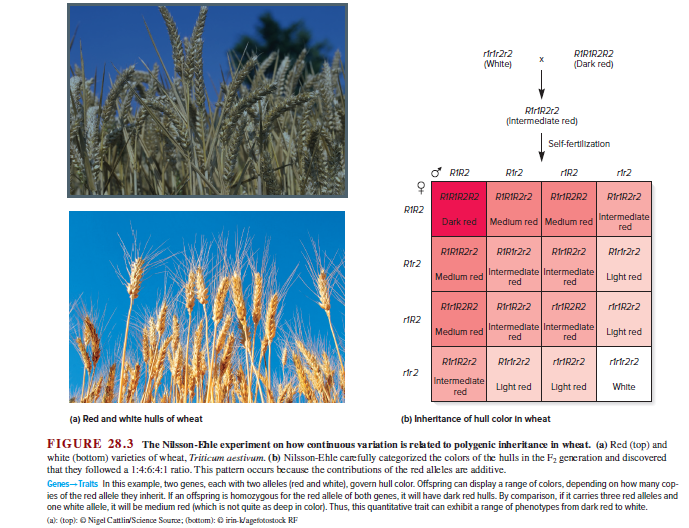rfrfr2r2 (White) RIRIRZR2 х (Dark red) RirtR2r2 (Intermediate red) Self-fertilization RIR2 R1:2 rIR2 rir2 RIRIRZR2 RIRIRZ12 RirIR2R2 RirIR2r2 RIR2 Intermediate red Dark red Medium red Medium red RIRIR212 RIRIr2r2 RirIR2r2 Rirtr2r2 Rir2 Intermediate Intermediate red Medlum red Light red red RirIRZR2 RirIRZr2 rfrfRZR2 rfrIR2r2 rMR2 Intermediate Intermediate red Medlum red Light red red RirIR2r2 Rirtr2r2 rirMR2r2 rfrtr2r2 rir2 Intermediate red Light red Light red White (a) Red and white hulls of wheat (b) Inheritance of hull color in wheat FIGURE 28.3 The Nilsson-Ehle experiment on how continuous variation is rekated to polygenic inheritance in wheat. (a) Red (top) and white (bottom) varieties of wheat, Triricum aestivum. (b) Nilsson-Ehle carefully categorized the colors of the hulls in the F2 generation and discovered that they followed a 1:4:6:4:1 ratio. This pattern occurs because the contributions of the red alkles are additive. Genes-Tralts In this example, two genes, each with two alleles (red and white), govern hull color. Offspring can display a range of colors, depending on how many cop- ies of the red allele they inherit. If an offspring is homozygous for the red allele of both genes, it will have dark red hulls. By comparison, if it carries three red alleles and one white allele, it will be medium red (which is not quite as deep in color). Thus, this quantitative trait can exhibit a range of phenotypes from dark red to white. (a): (top): O Nigel Cattlin/Science Source; (bottom): O irin-k/agetotostock RF
rfrfr2r2 (White) RIRIRZR2 х (Dark red) RirtR2r2 (Intermediate red) Self-fertilization RIR2 R1:2 rIR2 rir2 RIRIRZR2 RIRIRZ12 RirIR2R2 RirIR2r2 RIR2 Intermediate red Dark red Medium red Medium red RIRIR212 RIRIr2r2 RirIR2r2 Rirtr2r2 Rir2 Intermediate Intermediate red Medlum red Light red red RirIRZR2 RirIRZr2 rfrfRZR2 rfrIR2r2 rMR2 Intermediate Intermediate red Medlum red Light red red RirIR2r2 Rirtr2r2 rirMR2r2 rfrtr2r2 rir2 Intermediate red Light red Light red White (a) Red and white hulls of wheat (b) Inheritance of hull color in wheat FIGURE 28.3 The Nilsson-Ehle experiment on how continuous variation is rekated to polygenic inheritance in wheat. (a) Red (top) and white (bottom) varieties of wheat, Triricum aestivum. (b) Nilsson-Ehle carefully categorized the colors of the hulls in the F2 generation and discovered that they followed a 1:4:6:4:1 ratio. This pattern occurs because the contributions of the red alkles are additive. Genes-Tralts In this example, two genes, each with two alleles (red and white), govern hull color. Offspring can display a range of colors, depending on how many cop- ies of the red allele they inherit. If an offspring is homozygous for the red allele of both genes, it will have dark red hulls. By comparison, if it carries three red alleles and one white allele, it will be medium red (which is not quite as deep in color). Thus, this quantitative trait can exhibit a range of phenotypes from dark red to white. (a): (top): O Nigel Cattlin/Science Source; (bottom): O irin-k/agetotostock RF
Chapter2: Multiplication And Division Of Decimals
Section: Chapter Questions
Problem 6.4P
Related questions
Question
What does it mean to say that these alleles are additive?

Transcribed Image Text:rfrfr2r2
(White)
RIRIRZR2
х
(Dark red)
RirtR2r2
(Intermediate red)
Self-fertilization
RIR2
R1:2
rIR2
rir2
RIRIRZR2
RIRIRZ12
RirIR2R2
RirIR2r2
RIR2
Intermediate
red
Dark red
Medium red Medium red
RIRIR212
RIRIr2r2
RirIR2r2
Rirtr2r2
Rir2
Intermediate Intermediate
red
Medlum red
Light red
red
RirIRZR2
RirIRZr2
rfrfRZR2
rfrIR2r2
rMR2
Intermediate Intermediate
red
Medlum red
Light red
red
RirIR2r2
Rirtr2r2
rirMR2r2
rfrtr2r2
rir2
Intermediate
red
Light red
Light red
White
(a) Red and white hulls of wheat
(b) Inheritance of hull color in wheat
FIGURE 28.3 The Nilsson-Ehle experiment on how continuous variation is rekated to polygenic inheritance in wheat. (a) Red (top) and
white (bottom) varieties of wheat, Triricum aestivum. (b) Nilsson-Ehle carefully categorized the colors of the hulls in the F2 generation and discovered
that they followed a 1:4:6:4:1 ratio. This pattern occurs because the contributions of the red alkles are additive.
Genes-Tralts In this example, two genes, each with two alleles (red and white), govern hull color. Offspring can display a range of colors, depending on how many cop-
ies of the red allele they inherit. If an offspring is homozygous for the red allele of both genes, it will have dark red hulls. By comparison, if it carries three red alleles and
one white allele, it will be medium red (which is not quite as deep in color). Thus, this quantitative trait can exhibit a range of phenotypes from dark red to white.
(a): (top): O Nigel Cattlin/Science Source; (bottom): O irin-k/agetotostock RF
Expert Solution
This question has been solved!
Explore an expertly crafted, step-by-step solution for a thorough understanding of key concepts.
This is a popular solution!
Trending now
This is a popular solution!
Step by step
Solved in 4 steps

Knowledge Booster
Learn more about
Need a deep-dive on the concept behind this application? Look no further. Learn more about this topic, biology and related others by exploring similar questions and additional content below.Recommended textbooks for you

